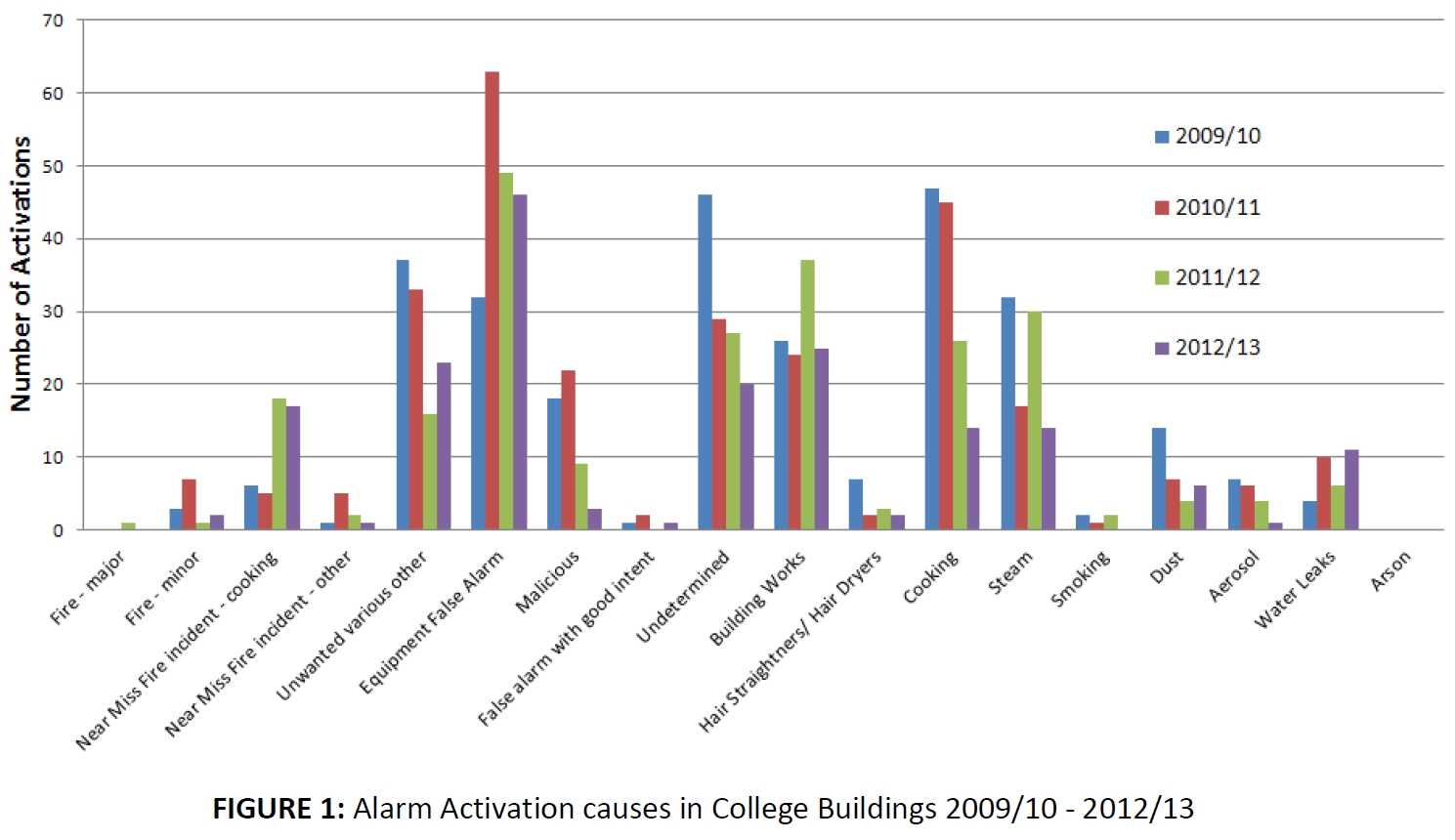The causes of false fire alarms in buildings
A false alarm is a fire alarm signal resulting from a cause, or causes, other than a fire, in which a fire detection and alarm system has responded, such as:
- A fire-like phenomenon or environmental influence (such as smoke from a nearby bonfire).
- Accidental damage.
- Inappropriate human action (such as malicious manual call point (MCP) activation).
- Equipment false alarms, resulting from a fault in the system.
A false alarm becomes an unwanted fire signal (UWFS) when the Fire and Rescue Service (FRS) is requested to attend.
In the period 2011-2012 there were 584,500 alarms reported in Britain. 53.4% of these were not fires and therefore considered “False alarms”. This is a drain on the FRS authorities and causes business disruptions leading to a loss of productivity and reducing the confidence of the general public.
False alarms generated from remotely monitored fire detection and fire alarm systems cost businesses and FRS authorities an estimated £1 billion a year in the UK. Ref London Fire Brigade 2012.
The causes of false fire alarms in buildings was written by R. Chagger, D. Smith and published by BRE Global in 2014. The briefing paper collates information about the causes of false alarms in buildings and identifies approaches to reduce their occurrence.
It was based on data from Kings College London and Buckinghamshire & Milton Keynes Fire Authority. The data supplied provides a snapshot of the types of false alarms that are observed but is not a comprehensive account of what might be the most common causes in the UK.
Kings College London provided data from 699 false alarm incidents and following a thorough review of the data, 6 physical interventions were identified that would address all of the false alarms reported. Replacement of the existing detectors with intelligent multi-sensor detectors (that detect more than one fire phenomena) was the solution that could reduce false alarms the most (by 69%).
Discussions with the Unwanted Fire Signals Officer of Buckinghamshire and Milton Keynes Fire Authority and analysis of their false alarm trends revealed that the use of a technical and experienced individual dedicated to investigating false alarms and engaging directly with regular offenders is a very effective means for FRS’s to reduce false alarms.
However, reducing the number of false alarms from domestic premises remains a challenge despite the fact that the vast majority are reportedly related to cooking incidents. Educating homeowners on effective installation and use of detectors in and around kitchens is likely to lead to the greatest reduction in false alarms from the domestic environment.
The Incident Recording System, used by Fire Officers to report on all callouts attended, lacks sufficient detail to accurately classify false alarm causes. However educating building owners, responsible persons and the general public could contribute significantly to reducing false alarms as simple measures can often cause notable reductions.
In addition, the increased use of multi-sensor detectors may avert false alarms from common causes such as cooking fumes, steam and so on.
[edit] Related articles on Designing Buildings Wiki
- BRE articles on Designing Buildings Wiki.
- Carbon monoxide detector.
- Fire.
- Fire detection and alarm system.
- Fire performance of external thermal insulation for walls of multistorey buildings, third edition (BR 135).
- Fire protection engineering.
- Heat alarm.
- Ionisation smoke alarm.
- Intruder alarm.
- Live investigations of false fire alarms.
- Multi-sensor alarm.
- New requirements for fire detection and alarm network systems IP 12 13.
- Optical smoke alarm.
- Over £1 billion lost every year due to false alarms.
- Project SHOUT.
- Smoke alarm.
- The role of codes, standards and approvals in delivering fire safety.
- Understanding the factors affecting flashover of a fire in modern buildings.
Featured articles and news
RTPI leader to become new CIOB Chief Executive Officer
Dr Victoria Hills MRTPI, FICE to take over after Caroline Gumble’s departure.
Social and affordable housing, a long term plan for delivery
The “Delivering a Decade of Renewal for Social and Affordable Housing” strategy sets out future path.
A change to adoptive architecture
Effects of global weather warming on architectural detailing, material choice and human interaction.
The proposed publicly owned and backed subsidiary of Homes England, to facilitate new homes.
How big is the problem and what can we do to mitigate the effects?
Overheating guidance and tools for building designers
A number of cool guides to help with the heat.
The UK's Modern Industrial Strategy: A 10 year plan
Previous consultation criticism, current key elements and general support with some persisting reservations.
Building Safety Regulator reforms
New roles, new staff and a new fast track service pave the way for a single construction regulator.
Architectural Technologist CPDs and Communications
CIAT CPD… and how you can do it!
Cooling centres and cool spaces
Managing extreme heat in cities by directing the public to places for heat stress relief and water sources.
Winter gardens: A brief history and warm variations
Extending the season with glass in different forms and terms.
Restoring Great Yarmouth's Winter Gardens
Transforming one of the least sustainable constructions imaginable.
Construction Skills Mission Board launch sector drive
Newly formed government and industry collaboration set strategy for recruiting an additional 100,000 construction workers a year.
New Architects Code comes into effect in September 2025
ARB Architects Code of Conduct and Practice available with ongoing consultation regarding guidance.
Welsh Skills Body (Medr) launches ambitious plan
The new skills body brings together funding and regulation of tertiary education and research for the devolved nation.
Paul Gandy FCIOB announced as next CIOB President
Former Tilbury Douglas CEO takes helm.
UK Infrastructure: A 10 Year Strategy. In brief with reactions
With the National Infrastructure and Service Transformation Authority (NISTA).
























